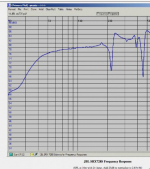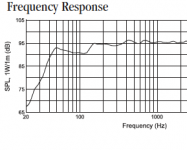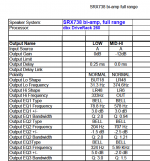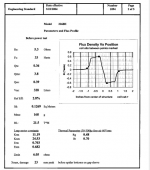Hi all,
At first please apologize for my english, I am french!
I bought a pair of JBL SRX738 using the 18¨ 2268HPL (neodynium, differential drive). The measurements show a very low distortion even driven at high power (thanks to the differential drive); but a frequency response not so good at medium frequencies (#3dB rised level above 250Hz, with peaks).
The enclosure is obviously not built as an ¨audiophile¨ one, the panels are not so thick and not well damped...
I found the sound quiet colored and not very dynamic ... not punchy... my previous subwoofer (with two PR380T4 AUDAX in a ¨manifold¨ loading) was souding a great better!
For information I use a triamp system with a digital active crossover XTA.
So I would like to design a good enclosure for that 2268 - for a 40Hz to 350Hz range. Flat frequency response, low distortion and good ¨dynamic¨ response are what I am looking for.
I don't want a 20Hz sub.
After some simulations I was thinking about a 150 liters /40Hz bass-reflex enclosure.
What are your suggestions for loading that 2268, and what are your experiences with this driver?
Do you enjoy its sound?
Thanks in advance,
Regards
Massilia
At first please apologize for my english, I am french!
I bought a pair of JBL SRX738 using the 18¨ 2268HPL (neodynium, differential drive). The measurements show a very low distortion even driven at high power (thanks to the differential drive); but a frequency response not so good at medium frequencies (#3dB rised level above 250Hz, with peaks).
The enclosure is obviously not built as an ¨audiophile¨ one, the panels are not so thick and not well damped...
I found the sound quiet colored and not very dynamic ... not punchy... my previous subwoofer (with two PR380T4 AUDAX in a ¨manifold¨ loading) was souding a great better!
For information I use a triamp system with a digital active crossover XTA.
So I would like to design a good enclosure for that 2268 - for a 40Hz to 350Hz range. Flat frequency response, low distortion and good ¨dynamic¨ response are what I am looking for.
I don't want a 20Hz sub.
After some simulations I was thinking about a 150 liters /40Hz bass-reflex enclosure.
What are your suggestions for loading that 2268, and what are your experiences with this driver?
Do you enjoy its sound?
Thanks in advance,
Regards
Massilia
Just another point; the idea should be to design a well damped enclosure (30mm birch plywood panels) with a ¨domestical¨ volume (lower than 200 liters - 7cubic foot) properly optimized.
PA 18" drivers are generally crossed below 150 Hz and preferably around 100 Hz. In the intended frequency range a (good) 15" will have a (much) higher chance of approval.
Best regards Johan
Best regards Johan
..lower than 200 liters - 7cubic foot) properly optimized.
Hi,
Here is a possible suggestion that uses a net volume of less than 200L and a baffle thickness of 36 mm: The picture.
Tweak this HR sim. further to suit your requirements!
b🙂
Attachments
Bjorno,
Thanks a lot! for all that simulations. The results seem nice.
If I understand well the project is a 200L /38Hz Bass Reflex? I am not so sure looking at the schematic diagram.
How can we explain the behavior above 500Hz?
For my project, I would keep the JBL CMCD-81H (horn loaded midrange 8¨ differential drive) for the 350Hz-2kHz range (this part is included in the SRX738).
So this 18¨ should be used in the 40-350Hz bandwidth (its waterfall and lack of distortion up to 2kHz are OK with it I believe, even if I agree with Rademakers that 18¨ are often used only as subwoofer).
Thanks
Thanks a lot! for all that simulations. The results seem nice.
If I understand well the project is a 200L /38Hz Bass Reflex? I am not so sure looking at the schematic diagram.
How can we explain the behavior above 500Hz?
For my project, I would keep the JBL CMCD-81H (horn loaded midrange 8¨ differential drive) for the 350Hz-2kHz range (this part is included in the SRX738).
So this 18¨ should be used in the 40-350Hz bandwidth (its waterfall and lack of distortion up to 2kHz are OK with it I believe, even if I agree with Rademakers that 18¨ are often used only as subwoofer).
Thanks
Bjorno,
Thanks a lot! for all that simulations. The results seem nice.
If I understand well the project is a 200L /38Hz Bass Reflex? I am not so sure looking at the schematic diagram.
How can we explain the behavior above 500Hz?
For my project, I would keep the JBL CMCD-81H (horn loaded midrange 8¨ differential drive) for the 350Hz-2kHz range (this part is included in the SRX738).
So this 18¨ should be used in the 40-350Hz bandwidth (its waterfall and lack of distortion up to 2kHz are OK with it I believe, even if I agree with Rademakers that 18¨ are often used only as subwoofer).
Thanks
Hi Masillia,
Don't worry about the dips and peaks:
They are artifacts from the fact that the box when empty,was simulated without any damping materials.
To cure: Line the rear internal wall with a suitable layer of foam or a sheath of polyester and the ripple will in practice disappear...
As the simulation shows, you will reach 350 Hz without flaws but this depends on your box internal layout as you will reach the speaker driver mass-corner when at ~170 Hz where the FR starts sloping.
b🙂
The 2268H is quite flat in the upper response:Hi Masillia,
Don't worry about the dips and peaks:
They are artifacts from the fact that the box when empty,was simulated without any damping materials.
To cure: Line the rear internal wall with a suitable layer of foam or a sheath of polyester and the ripple will in practice disappear...
As the simulation shows, you will reach 350 Hz without flaws but this depends on your box internal layout as you will reach the speaker driver mass-corner when at ~170 Hz where the FR starts sloping.
b🙂
2268H
In testing the SRX 728, which uses the 2268H I found there was a big peak/dip around 230 Hz, probably from the port.
The spec sheet graph stops before that point ;^).
bjorno, the JBL specs I found wrongly put the Xlim of 23mm as the Xmax figure. where did you find the Xmax of 8mm for the 2268HPL?
Are the parameters different for the 2268HPL than for the 2268H ?
Art
Last edited:
Hi Weltersys,
There are three models of the 2268:
2268FF
2268G
2268H which is the same as HPL
You can find the TS parameters here:
http://www.jblproservice.com/pdf/Thiele ... meters.pdf
In the SRX series it is the HPL version.
I would be very interested in looking at some measurements you performed on this SRX 728, and your opinion about the sound of that subwoofer.
In the SRX738 I found it not punchy, and colored in the upper bass - due I expect, to the enclosure. Using it in active mode.
Regards
There are three models of the 2268:
2268FF
2268G
2268H which is the same as HPL
You can find the TS parameters here:
http://www.jblproservice.com/pdf/Thiele ... meters.pdf
In the SRX series it is the HPL version.
I would be very interested in looking at some measurements you performed on this SRX 728, and your opinion about the sound of that subwoofer.
In the SRX738 I found it not punchy, and colored in the upper bass - due I expect, to the enclosure. Using it in active mode.
Regards
Hi Weltersys,
There are three models of the 2268:
2268FF
2268G
2268H which is the same as HPL
You can find the TS parameters here:
http://www.jblproservice.com/pdf/Thiele ... meters.pdf
In the SRX series it is the HPL version.
I would be very interested in looking at some measurements you performed on this SRX 728, and your opinion about the sound of that subwoofer.
In the SRX738 I found it not punchy, and colored in the upper bass - due I expect, to the enclosure. Using it in active mode.
Regards
Massilia,
The JBL TS parameters that you referenced are the ones that show the Xlim of 23 mm as the Xmax figure, bjorno used 8 mm as Xmax, which sounds right, though I’d like to see the source, as I have seen many discussions speculating as to what the actual Xmax is, usually guessing about 11 mm.
My actual experience with the SRX 728 was setting up a DBX DriveRackPA for a DJ using pink noise and Smaart. I did not get to listen to it with actual music, but the 728 and the 718 are well regarded for subs in their price range.
My test had filters engaged, so it does not show the upper range, the graph below from one of Wayne Parham’s sub shootouts shows the port artifacts better than my test, and the LF rolloff looks very much the same in both my test, Wayne's and the JBL published graph. Since the port artifacts are narrow dips, rather than peaks, they should not be very noticeable.
As you can see, the present tuning of the 738 looks to be just below 50 Hz, I would suggest lengthening the ducts to tune the Fb down around 38 Hz, which would reduce the 50 Hz “bump” that is “coloring” the sound.
A lower tuning will sound much more “damped”, and be easier to EQ.
Though tuning lower will reduce LF output in the 50 Hz range, the lower, more gradual extension may actually sound “louder”, worth a try before building a separate cabinet, which would disassociate the LF/MF (if you don’t cut the bass portion of the 738 off, ruining it’s resale value), not a good idea with such a high crossover point.
Regarding lack of “punch”, the time alignment difference at the crossover point between the woofer and mid horn could be the problem, the mid/high portion (or the woofer) may need delay added.
Using a test tone at the crossover point, reverse the polarity of the LF, add delay to the top portion in small increments, the point where the output is least on your dB meter is the correct delay, though it should not be more than about 1-3 milliseconds. A wavelength at 315 Hz is just over a meter, if you end up with a delay in the 7 ms range for the null, the delay is one full wavelength late. If adding delay makes the null less as delay is added to the top, the LF may need delay instead.
Put the polarity back to normal after the proper delay is determined.
If you have an RTA or dual FFT test gear, pink noise will show the reverse polarity null to be deepest at crossover point, pick an ISO center (315 or 400 Hz) if using an RTA The crossover point should be reset to the recommended point after the alignment is done.
The tests are best done outdoors, microphone on the ground about 2 meters from the cabinet front, midpoint between the mid horn and woofer, cabinet laying horizontal, both microphone and cabinet well away (at least four meters) from any walls.
Art Welter
Attachments
Hi Art,
Thanks a lot for all those explanations.
About the 23mm surely it's the maximum-before-damage excursion rather than max linear displacement.
When I did setup on the SRX738 I used a XTA digital crossover, and made measurements with 1/24e octave resolution. I used the delay according to JBL setup (for time-alignment between all 3 sections of the SRX738). It was measured outdoor.
Your method for the delay is very interesting, I will try it next time.
Thanks,
Regards
Bruno
Thanks a lot for all those explanations.
About the 23mm surely it's the maximum-before-damage excursion rather than max linear displacement.
When I did setup on the SRX738 I used a XTA digital crossover, and made measurements with 1/24e octave resolution. I used the delay according to JBL setup (for time-alignment between all 3 sections of the SRX738). It was measured outdoor.
Your method for the delay is very interesting, I will try it next time.
Thanks,
Regards
Bruno
Bruno,Hi Art,
Thanks a lot for all those explanations.
About the 23mm surely it's the maximum-before-damage excursion rather than max linear displacement.
When I did setup on the SRX738 I used a XTA digital crossover, and made measurements with 1/24e octave resolution. I used the delay according to JBL setup (for time-alignment between all 3 sections of the SRX738). It was measured outdoor.
Your method for the delay is very interesting, I will try it next time.
Thanks,
Regards
Bruno
Yes, the 23 mm is Xlim (Xmech) as stated in the bottom of the Engineering Standard #1894 (spider bottoms on gap sleeve), but I have yet to find an official JBL correction or Xmax figure, the Parts Express version of the specs say 8 mm for Xmax (thanks bjorno).
JBL’s tuning shows a .25 ms delay on the low for the DR 260, I had not looked at it when I wrote my response.
I could understand those tunings sounding quite “off”, they appear to be attempting to correct the (too high) box alignment chosen to help compensate for the 12-15 dB disparity between woofer and mid/high sensitivity. Lowering Fb would help in many ways.
Unfortunately, latency and filter types in different platforms are different, what works on one DSP does not necessarily (or even typically) translate to others.
JBL’s “tunings” were often not very good, it is interesting to hear Vertec users say the V. whatever presets make the box sound completely different and better, implying that the old settings were indeed lousy.
Anyway, the delay null test I outlined will work for any DSP platform and filter choice.
Art Welter
Attachments
My experience with this SRX738 was that the JBL setup was indeed not optimized.
The corrections I set using the XTA were completely different.
The global frequency response of my SRX738 (modified to be tri-amped) was then set smooth (excepted the large dip around 15kHz due to the 2431/PT horn). In the 40Hz-350Hz it was a lot better than JBL's plot.
I measured indeed very low distorsion on the whole bandwidth.
At hearing; it was correct at low level, there was no audible distortion at high level but a coloration was then easily audible - due to the enclosure I think.
The high frequency part was not really good, a 2446 with a CD horn sounds a lot better.
If I compare to my references in term of bass impact using 18¨ (old 4818 JBL, Funktion One F218... which are all folded horn designs, or even T21 Adamson with two 21¨ units), the sound of the 2268 in the SRX738 is very different... sounds much like ¨HiFi¨ conventional designs (flat, not punchy, no ¨kick¨).
Hoping a better design/enclosure will improve it!
Regards
Bruno
The corrections I set using the XTA were completely different.
The global frequency response of my SRX738 (modified to be tri-amped) was then set smooth (excepted the large dip around 15kHz due to the 2431/PT horn). In the 40Hz-350Hz it was a lot better than JBL's plot.
I measured indeed very low distorsion on the whole bandwidth.
At hearing; it was correct at low level, there was no audible distortion at high level but a coloration was then easily audible - due to the enclosure I think.
The high frequency part was not really good, a 2446 with a CD horn sounds a lot better.
If I compare to my references in term of bass impact using 18¨ (old 4818 JBL, Funktion One F218... which are all folded horn designs, or even T21 Adamson with two 21¨ units), the sound of the 2268 in the SRX738 is very different... sounds much like ¨HiFi¨ conventional designs (flat, not punchy, no ¨kick¨).
Hoping a better design/enclosure will improve it!
Regards
Bruno
Probably all the designs you mentioned were crossed more in the 100-200 Hz range, allowing a lot of the "punch" to come from the top cabinet.My experience with this SRX738 was that the JBL setup was indeed not optimized.
If I compare to my references in term of bass impact using 18¨ (old 4818 JBL, Funktion One F218... which are all folded horn designs, or even T21 Adamson with two 21¨ units), the sound of the 2268 in the SRX738 is very different... sounds much like ¨HiFi¨ conventional designs (flat, not punchy, no ¨kick¨).
Hoping a better design/enclosure will improve it!
Regards
Bruno
Hard to get "punch" out of an 18 crossed in the 350 Hz range, and the short mid horn won't make it down much lower, so you are kind of stuck.
I built 16 three way cabinets using a little mid horn and 18" for the bass, I finally cut the bass cabinet portion off and used them for subs and used the top components over in larger horns, never could get the transition from the 18 to the little mid horn to sound good.
Hi,
For information the 4818 was to be used up to 250Hz, related by a 12" front horn loaded.
Same thing for Martin Audo B115 folded horn.
I note your conclusion, experience based, that a 18" should be used as a subwoofer.
A question: what do you thing of SBB4 or Bessel-alignment reflex load, do they really sound better than a QB3 (quasi Butterworth) for example, due to the lower group delay for frequencies higher than the cut-off?
Thanks in advance
For information the 4818 was to be used up to 250Hz, related by a 12" front horn loaded.
Same thing for Martin Audo B115 folded horn.
I note your conclusion, experience based, that a 18" should be used as a subwoofer.
A question: what do you thing of SBB4 or Bessel-alignment reflex load, do they really sound better than a QB3 (quasi Butterworth) for example, due to the lower group delay for frequencies higher than the cut-off?
Thanks in advance
I have not really considered group delay in listening to cabinets, but in general for a "full range" alignment as in your cabinet, or a ported speaker going up past 100 Hz or so, I prefer an alignment that does not result in a "bump" at Fb.Hi,
For information the 4818 was to be used up to 250Hz, related by a 12" front horn loaded.
Same thing for Martin Audo B115 folded horn.
I note your conclusion, experience based, that a 18" should be used as a subwoofer.
A question: what do you thing of SBB4 or Bessel-alignment reflex load, do they really sound better than a QB3 (quasi Butterworth) for example, due to the lower group delay for frequencies higher than the cut-off?
Thanks in advance
I think the 50 Hz "boom" that the high tuning of the 738 has would be annoying from what I have heard in similar alignments. The 718 is tuned lower than the 738, and the 728 lower yet, so it has a rolloff in the bottom.
In fact, looking at the 728 response it is not immediately apparent where Fb is at all.
The 738 may be a bit smaller 18" chamber than the 728, but it still could be tuned a lot lower than present without loosing too much LF.
At lower volume you could easily cover 1/2 or so of the port(s) and see if the lower tuning eliminates some of the sound quality issues, if it does you could do a proper port extension.
Hi Art,
The SRX 738 ports are only openings in the front panel, without tubes. So the tuning frequency can indeed be lowered, as you suggest.
For the behavior of the enclosure itself, I am afraid I have to build a new one with 2.5" thick birchplywood panels, with bracing, to do it well.
Thanks,
Regards,
Bruno
The SRX 738 ports are only openings in the front panel, without tubes. So the tuning frequency can indeed be lowered, as you suggest.
For the behavior of the enclosure itself, I am afraid I have to build a new one with 2.5" thick birchplywood panels, with bracing, to do it well.
Thanks,
Regards,
Bruno
Mistake!!
It's not 2.5¨ thickness of course but 12¨ (30mm) thickness I want to use for the panels of my 2268 enclosure.
Sorry...
It's not 2.5¨ thickness of course but 12¨ (30mm) thickness I want to use for the panels of my 2268 enclosure.
Sorry...
33 years ago I used 1.25 inch (about 30mm) material for bass cabinets.Mistake!!
It's not 2.5¨ thickness of course but 12¨ (30mm) thickness I want to use for the panels of my 2268 enclosure.
Sorry...
I haven't used anything that thick for portable cabinets since.
I think the sound problems you speak of are tuning problems, not panel thickness problems. If there are panel vibration problems, bracing is a better solution than thickness. Stuff the port with a towel, damp the cone with your hand, hit the cabinet with a rubber hammer (or your fist) and see if any panels ring low like a drum- I doubt they do with a trapazoidal birch ply cabinet.
Since the port is only 19 mm deep, experimentation with tuning is easy.
Like I wrote before, try lowering it to around 38 Hz (or lower) and see what you think.
It is easy to determine Fb , run a sine wave into the cabinet, the excursion will be at minimum at Fb, it is easy to see the excursion if you put a white dot on the cone. Smaller ports tune lower, longer ports tune lower.
The Fb is somewhere around 50 Hz now, lowering it will make a big difference in the sound of the cabinet, it's more of a boom box than a sub the way it is tuned now.
I would like to buy the loaded horns from these enclosures if you want to sell. Please email me if you are interested.
moorereinforcement@gmail.com
moorereinforcement@gmail.com
I would like to buy the loaded horns from these enclosures if you want to sell. Please email me if you are interested.
moorereinforcement@gmail.com
What "loaded horns"?
I don't have any more used bass horn cabinets, and the OP, in France, has bass reflex cabinets.
Art
- Status
- Not open for further replies.
- Home
- Loudspeakers
- Subwoofers
- JBL 2268 loading




